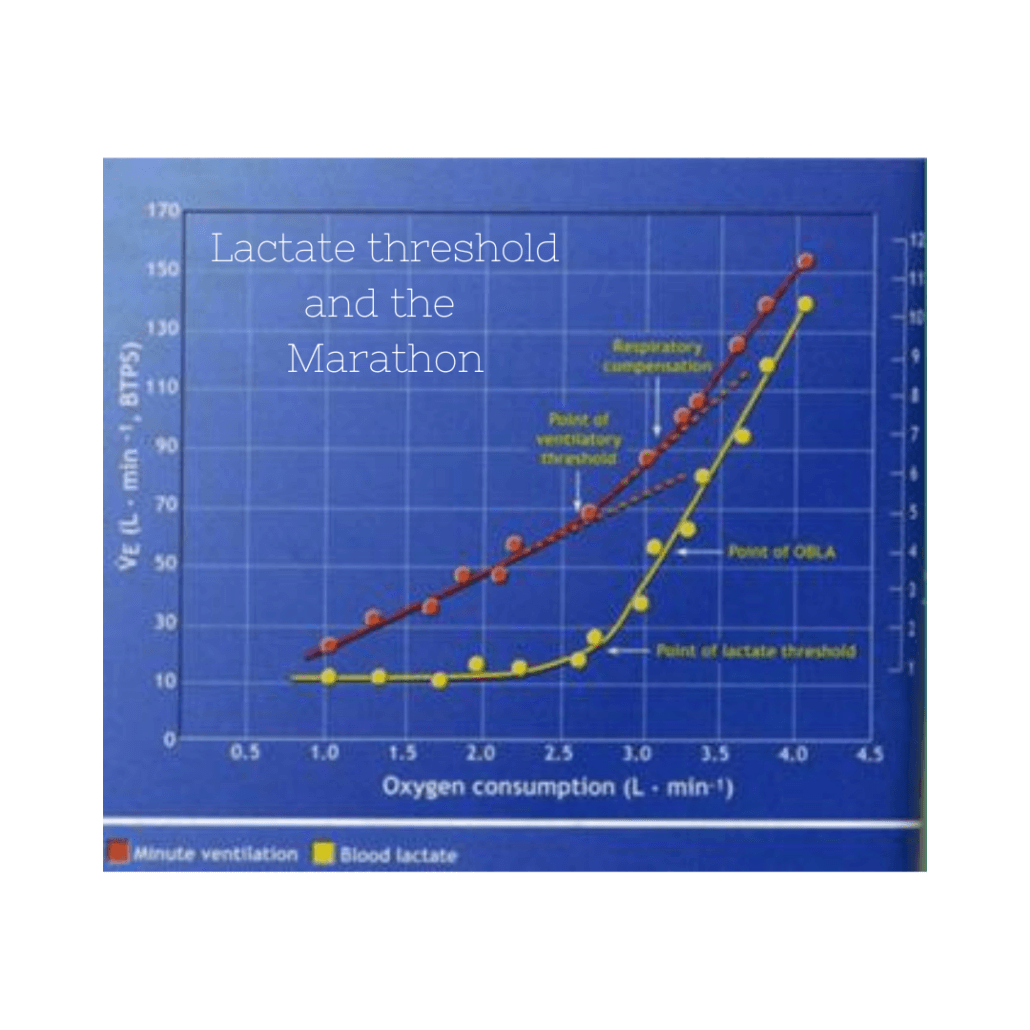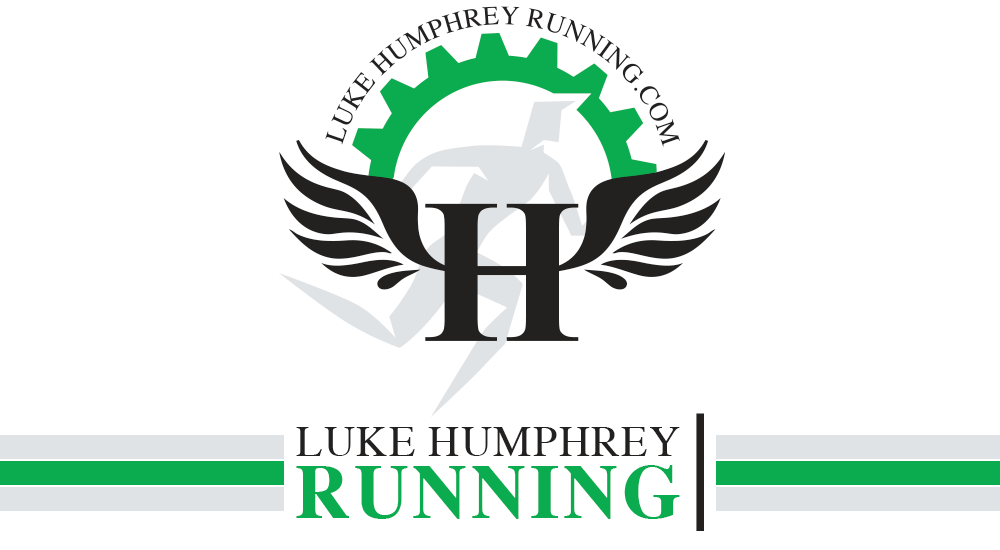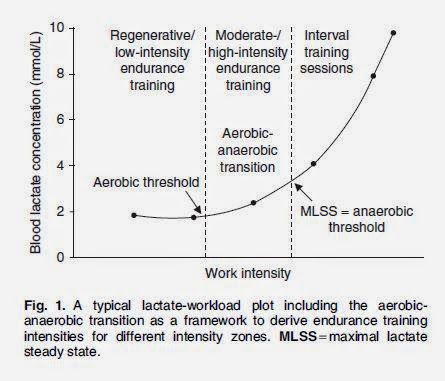Lactate threshold and the marathon

When I first started writing out this blog, I really just wanted something short and sweet to address the idea of lactate threshold and how to train for it. The more I jumped into it, the more I was going to need footnotes and caveats. Instead of doing all of that, I decided to start from the beginning. The problem is really two-fold. One, there are really two thresholds that need to be defined which causes confusion. The second is that there are multiple definitions for each of these threshold levels which just exacerbates the problem. So, I think that’s where we start- by clarifying these, and then we can look at the training for lactate threshold in the traditional sense.
In the figure above, you see the red line represented by a subject’s breathing and the yellow line represented by actual blood lactate measurements. If you were doing a traditional VO2max test you’d be charting the red line. The yellow line has to be from actually stopping and testing blood lactate levels with a finger prick. We won’t look at the red line intently, other than noting its correlation to blood lactate measurements. In a practical sense, your breathing can give you a good idea of where you are at.
Threshold One: In this chart, you see it as the “point of lactate threshold.” I have always understood this threshold as the aerobic threshold. When you read anything from me, I will be using the term aerobic threshold. Whatever you see it called, it simply represents the first noticeable rise in blood lactate levels and usually occurs at 1.7-2.4 mmol/dL. Like anything with training, the less fit you are, the sooner this occurs. For untrained people this might be at 50% VO2max, while for more trained, it might be 60% of your VO2max. What I really want you to take away from this is that this number will really be a representation of what kind of stimulus you need for easy run stimulus. That part honestly needs its own blog, but just note that if you are an advanced runner and trying to continue to grow your aerobic stimulus from easy/moderate running, then that pace will have to change. For a beginner runner, just note that you won’t have to do much more than run easy and you will be providing more than enough aerobic development stimulus.
Threshold Two: This is what I have always known as the lactate threshold, or anaerobic threshold (AT). You’ll also see it as the OBLA (onset of blood lactic acid), or MLSS (maximal lactate steady state). This threshold has traditionally been when the blood lactate levels reach 4.0 mmols and it represents the point of no return. By that, I mean, once you cross that point, the blood lactate levels will continue to rise exponentially, even if you keep the pace the same.
Now, most people don’t have access to blood lactate testing, so how can we accurately calculate what our AT pace is. Using races is usually the most convenient method- or if we don’t have that specific race needed, use a race equivalency chart to get an estimate. Let’s utilize MLSS first, which is identified not only by the 4 mmols of blood lactate, but also the pace at which a person can sustain a pace for about an hour. However, coach Jack Daniels writes that this is true for a well rested runner, in general you are looking a pace that a runner can currently hold for 20-30 minutes. Coach Vigill says that the pace is roughly what a person can hold over a 15 minute race. So, a big range. To be fair, Vigil’s writings are for more in competitive runners, highly competitive males. Whereas, I believe coach Daniels is encompassing a broader group. Where do we settle on? Well, when you dive a little deeper, they talk about running comfortably hard, or not being exhausted, but glad to be done. You also have to look at what volume is done (we’ll get into more specifics later), but general agreement is 20 minutes straight at this pace, or a bigger volume that is broken up- like 6×5 minutes or 3×10 minutes. When I combine all of that together, at face value you are looking at maybe 5k pace for a lot of people, but that doesn’t make sense. So, I tend to settle on the 10k-15k pace depending on the runners ability, 20k pace for sub/elite. That pace they could race at over about 45-60 minutes, but sustain that pace for about 30 minutes in a continual run at that time of training. The fact that Vigil suggests his stronger runners will occasionally do 6-10 miles at LT pace furthers my argument for the 15k-20k pace for longer LT workouts. Daniels actually suggests slowing down to marathon pace by the time you get to the 10 mile range.
Before I get into a rabbit hole a bit, let’s go over what is pretty universally accepted for LT workouts. As I mentioned you have the standard 20 minute run at threshold pace. This will be roughly 2-4 miles for the slower runner up to the more advanced runner. (Before I get hate mail, yes a 10 minute mile is slower than a 5 minute mile, which is what I am referencing). 20 minutes of straight-up running is a great stimulus for LT development.
The second is something that Daniels calls cruise intervals whereas Vigil just calls them long intervals. I am more familiar with Vigil’s style, but it’s pretty universally accepted that the intervals are usually either 5-15 minutes with 3-5 minutes active rest, with stronger runners pushing that out to 16-17 minutes to cover a full 5k on the repeat. For the later, the recovery is near complete. In either case, the goal is to be able to accumulate time near LT. If you can do 20 minutes straight up, then the goal would be to accumulate 30-40 minutes with relatively short breaks, making it much more manageable. How that relates to volume in terms of mileage, the only hard data I seen is about 10% of your weekly volume. So, if you run 50 miles a week, then up to 5 miles a week. That might get interesting when using the guidelines above- say you do a 3 mile run for your 20 minute threshold, do you do a secondary workout with 2 miles in there somewhere, and that’s where it gets interesting and you might have to get creative with workouts.
Why does LT matter that much for the marathon?
You may have gotten to this point, recognized that LT is a fairly intense “zone” to be hitting and wondering how it’s going to help you as a marathoner. The truth is, a lot. As you can see in the figure below, a person who is untrained can run fast, maybe as fast as a trained athlete. The problem is that it takes a lot more work and the trained person could hold those paces longer. I shouldn’t even just say trained vs untrained, because a lot of marathoners fall into two camps. The first is where they are speedsters and do a lot of stuff way over their LT. Or, they loathe speed and stick to marathon pace and long runs. In either case, they train, just not the LT specifically.
Looking at the above figure, you see that the trained runner produces less lactate at any speed across the board. Now, while we know that lactate isn’t the cause of fatigue, we do know it’s associated with it, so if we can run faster, but have it feel less hard, that’s a good thing. Now, are we going to be approaching your LT in the marathon, no, for most it’s not an issue. The faster you are, the closer you the threshold. Regardless of pace you run for the marathon, improving LT gives you a higher ceiling for what your marathon pace can be.
Essentially, what might happen is someone might have a pretty decent VO2max, but then become limited by what their LT is. The further we can develop the LT, the faster we can push that marathon pace. Ultimately, it’s not even just the marathon, the higher the LT, the more likely the winner of any race.
How does that work if you are using HMM?
As athletes of mine and readers of the book will ultimately be asking this question, it’s only fair to dive into this.
The conundrum with the plans is that depending on what you choose for paces and the level of runner you are, you stand a good chance of floating around that threshold. However, either the amount of time at the stimulus might not be right or the pace might be a little too fast or too slow. Remember, we are looking for 3-5 minutes to about 20 minutes per repeat at a touch under LT. We know the speed won’t be on the longer end of that spectrum, but would it work for the speed.
| Marathon | 5k Equiv Time | 5k Pace (miles) | 10k Equiv Time | 10k Pace (Miles) | ½ Equiv Time | ½ Pace (Miles) |
|---|---|---|---|---|---|---|
| 5:00:00 | 31:17 | 10:04 | 1:05:13 | 10:29 | 2:23:53 | 10:58 |
| 4:30:00 | 28:09 | 9:03 | 58:42 | 9:26 | 2:09:30 | 9:52 |
| 4:00:00 | 25:01 | 8:03 | 52:10 | 8:23 | 1:55:07 | 8:46 |
| 3:45:00 | 23:28 | 7:33 | 48:55 | 7:52 | 1:47:55 | 8:13 |
| 3:30:00 | 21:54 | 7:02 | 45:39 | 7:20 | 1:40:43 | 7:40 |
| 3:15:00 | 20:20 | 6:32 | 42:23 | 6:49 | 1:33:32 | 7:08 |
| 3:00:00 | 18:46 | 6:02 | 39:08 | 6:17 | 1:26:20 | 6:35 |
| 2:45:00 | 17:12 | 5:32 | 35:52 | 5:46 | 1:19:08 | 6:02 |
| 2:30:00 | 15:38 | 5:01 | 32:36 | 5:14 | 1:11:57 | 5:29 |
This section is really about the marathon and half marathon training, so if you are more of a 5k-10k runner, then we’ll have to look at it differently, but we’d be using an entirely different schedule, so shouldn’t be an issue. Just want that disclaimer.
4:00:00+ Marathoner
If you are using the Beginner Plan (which I would suggest for this group, regardless of experience) then 5k pace is probably actually pretty close to your LT. The “problem” is that the 400’s won’t accumulate enough time in the zone and be too long of a rest. But, that’s not a huge issue and if you are a person who doesn’t usually do workouts like that, then it’s a good practice go. I’d recommend doing the 400’s, 600’s and 800’s at 5k pace. That’s going to put you in that 3-5 minute range, the shorter time span for being able to stimulate the LT. So, we are going shorter bursts that are more intense. Once you get to the 1k’s through the 1600’s, you now approach that 10 minute range and so for these I would bump it up to 10k pace. With the beginner plan, you have five weeks of “speed” so you’d only get up to the 1200’s.
3:45 to 3:00:00 Marathoner
This range is probably the group with the most people seeking Boston, New York and other qualifiers. This will be a mixed bag of people using the beginner vs the advanced plans. If a person is using the beginner plan, but has experience with training, I probably wouldn’t do anything at 5k pace, nor would I do anything under an 800. I would maybe just stick to 800’s and work up from 800 through 1600 and then on the fifth week of speed, do something like a ladder workout (the one time I’d say do a 400) and I would keep everything at 10k pace. This being pretty high up as far as percentage of VO2max, along with the length of repeats would be more than enough to stimulate LT development, but also improve the speed at LT. Both of these things will be more beneficial to boosting your marathon capabilities than doing weeks or 400’s and 600’s at 5k pace. If you tried doing 5k pace for the 800’s and longer, then you are shooting over LT and then just making yourself more fatigued for the tempo on Thursday (and not really getting a ton of benefit out of the workout- just tired). If you are a person who has struggled with doing the Tuesday speed and then being able to turn around and do a tempo on Thursday, I’d really look at this setup.
For Advanced Plan users, pushing the pace close to three hours, things can probably be a little different. You actually have 9 weeks of Speed! That’s a lot of room. For you, I’d shake things up a bit. I think what’d do is take the first 4 weeks and keep it 400’s, 600’s, 800’s, then use the Pyramid workout as a transition. So I’d go 400’s and 800’s at 5k pace then the 1000’s through 1600 at 10k pace. A little 5k sandwich, if you will. Then the last 5 weeks, I’d focus on 1’k’s to 1600’s at 10k pace and put the emphasis on being 3-5 minutes at the top end of the LT range.
Sub 3:00:00 Marathoners
These are the men and women competing for wins and high finishes in races. Chances are, if they are using the OG Hansons plan, it will be the advanced plan. Given that, I’d just follow the guidelines in the previous paragraph. Not much I would change with this group. The only thing that might actually need to be done would be to reduce the recovery times to be a little shorter. No recovery for any of the speed workouts being done should be more than 2 minutes for this group.
Final thoughts on the speed workouts for the marathon
At the end of the day, I don’t feel like I am truly deviating from Kevin and Keith’s original idea of speed. When I look at what we would do during these types of workouts with the ODP and what the brothers would advocate during community runs (when speaking to the marathoners), it wasn’t about developing the top end speed of a runner, it was about developing their marathon speed. I can definitely see where that would be confusing from the outside looking in, but I think once you understand what the true purpose of the workout is, it becomes easier to adhere to that. I think that’s what happens a lot of times when a person picks up a book and it says 5k to 10k pace. That’s true, but there are caveats to that. Now, it’s been 10 years since the first edition was published and I think that would be something I would make clearer in the text.
What about strength workouts?
As we transition from Speed to Strength, are there adjustments to be made here? This gets tricky because in both schedules you have seven weeks of Strength workouts leading up to the race. That section of the plan we really want to be focused on being as marathon specific as possible. Out of curiosity, I looked at what other Big Time coaches had in their writings. Daniels was interesting in that over the last 6-8 weeks, the vast majority of work was done specifically at marathon pace, with a sprinkling of Threshold work sandwiched in. By sandwiched in, I mean sandwiched in between marathon pace in the same workout. Looking at Vigil, during the same time frame of a marathon plan, he too focuses on marathon pace, but has workouts that he just labels as “repeat miles” but they were basically 6×1 miles at 10-15 seconds faster than marathon pace. So, the reality is, I don’t think I would change anything with the strength workouts. When you look at the numbers, MP is anywhere from 15-18 seconds per mile slower than theoretical half marathon pace, as it is. Knowing how a lot of you operate, if I say 10 seconds faster per mile, then you think a successful workout is 15 seconds faster per mile! You know it’s true! So, leaving it alone still puts you pretty close to half marathon pace where you will get a stimulus just below threshold, but for much longer durations. This is a much better fit during this high volume, peak training, block. I fear if you went full threshold, it’d be too much.
What about the half marathon?
The half marathon plan should see an overhaul. In how it is treated for paces. However, this post has already been long enough.
The biggest thing I wanted to do was provide a better picture of what lactate threshold really is how it relates to performance. The second thing is how do we take that information and adjust a system that clearly works, but maybe make it even a little better or at least individualized. I think we did both of those things. The one thing that we didn’t really discuss, but I think is important is the fact that when we are training for a certain race, the marathon in particular, it presents a set of unique challenges. We have to put a fair amount of our eggs in a single basket. We can touch on all of these things like speed and lactate threshold, but the amount we are doing is a small amount that is relative to the distance being run. Given that, I think if just furthers the case of training for an array of different distances so that we can put emphasis on some of these “neglected” areas. The better we can do that, the better we can manage age related declines in performances, break plateaus, and reach levels we didn’t think possible. Anyway, I hope this puts some things in focus and gives you some things to think about.
Be sure to check out all of our membership plans and training plans!




This is so good and a timely confidence boost as I go back thru my training. It’s also kind of relevant (maybe not) to a post I’ve been trying to find from a year or so ago. Maybe it was a Facebook live? @lukehumphrey22 you were discussing why it was important to adjust for heat in order to stay aerobic with SOS. Training in Florida this is so relevant especially this winter which has been miserably warm. I like to arm myself with that kind of stuff as I reflect on my training to mentally prepare. But I can’t find it. Does it at all ring a bell??